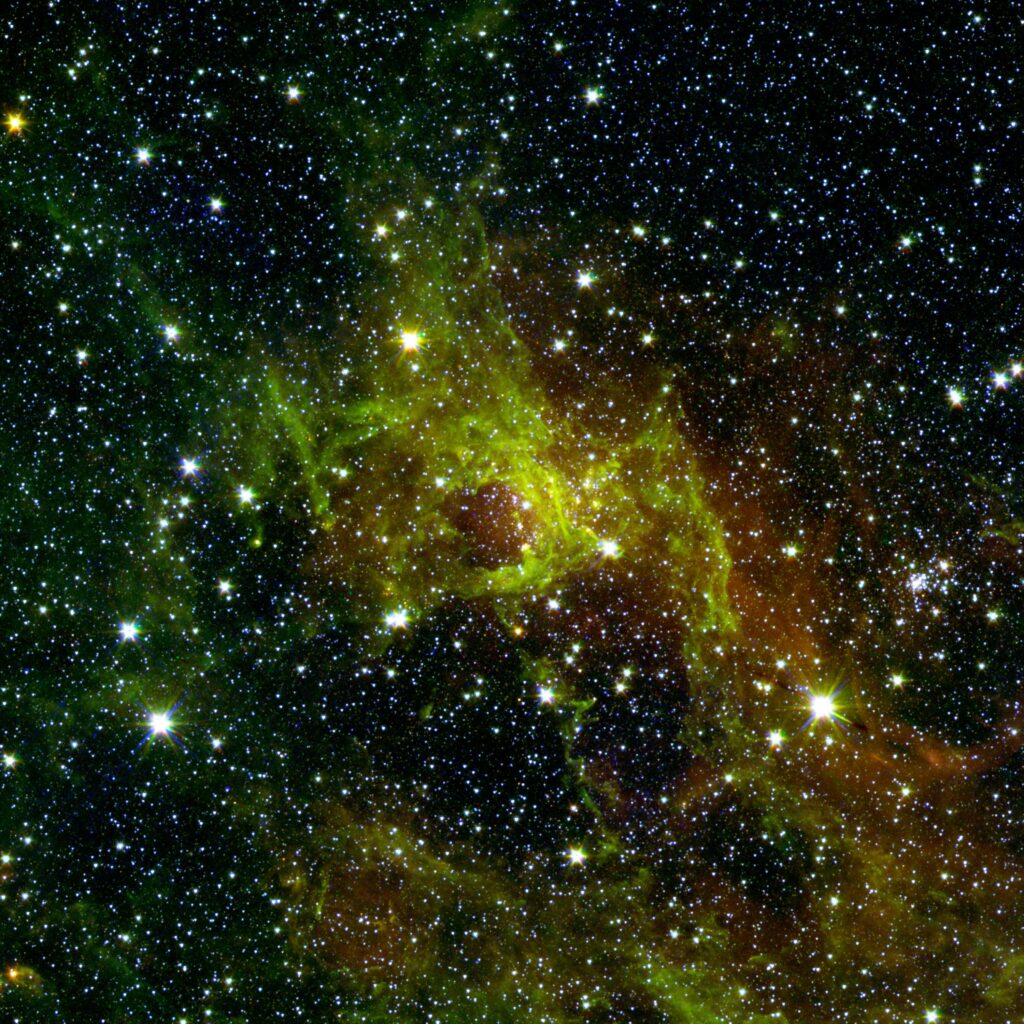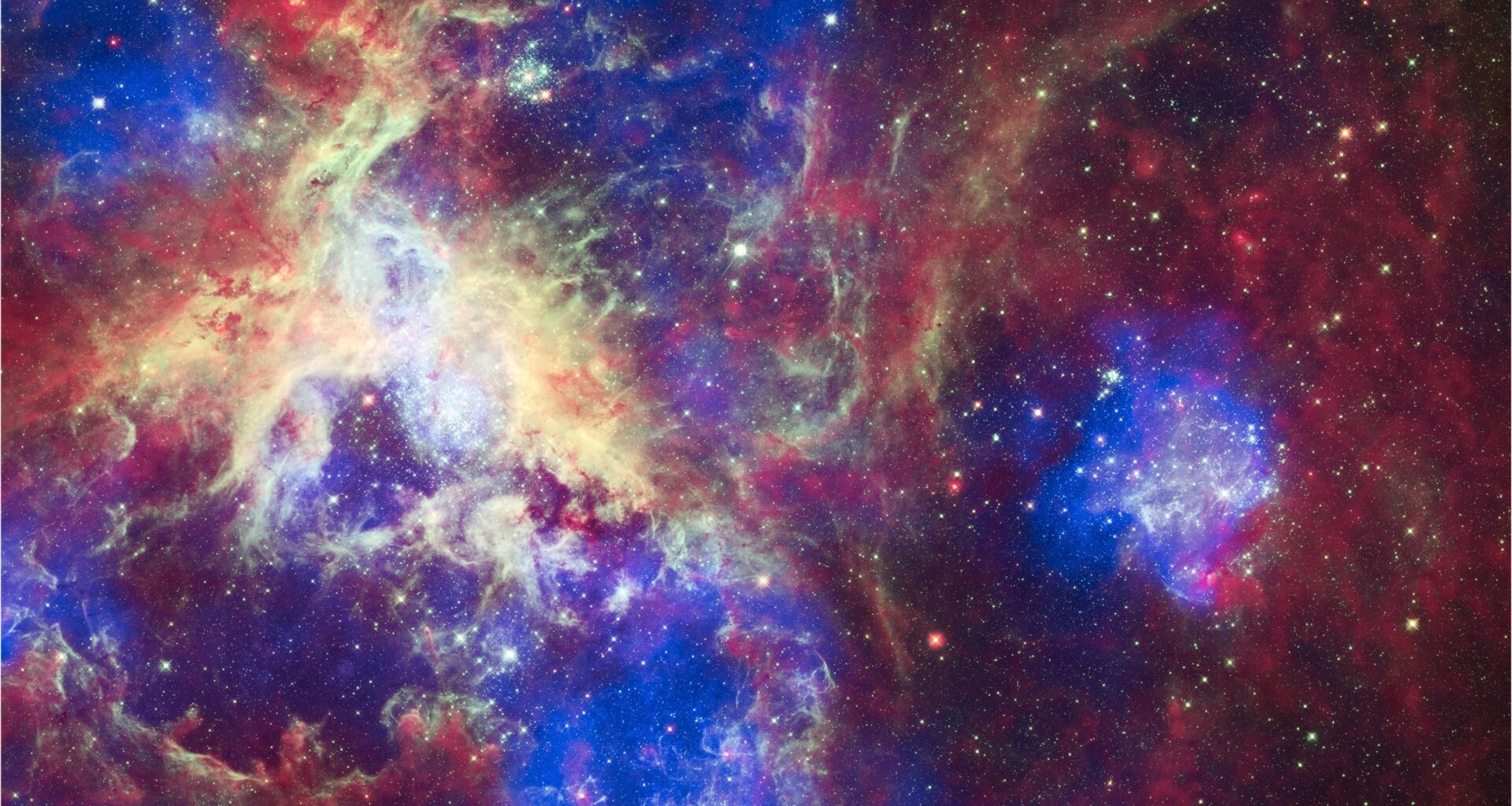The fascination that electronic music artists and fans have with worlds beyond Earth is being deepened by technological advancements and renewed intergalactic ambitions. And we’re also now starting to get answers to a question that’s bugged many of us for a long time. What does space actually sound like?
Karlheinz Stockhausen’s childhood might best be described as “unconventional”. His recollection of it was certainly different to that of the other kids who grew up in the rural community of Mödrath near Cologne.
After experiencing “visionary dreams”, the electronic music pioneer and irrepressible mythomaniac claimed his birth in 1928 took place not in an unremarkable German village but on a planet orbiting Sirius. “That’s not so out of this world,” he suggested of an upbringing within the glow of what is officially the brightest star in the night sky.
Music was, in Stockhausen’s perception, a way of somehow “transcending this Earth, transcending man and transcending human intelligence”. Like fellow visitant Sun Ra – apparently raised on the mean if gaseous streets of Saturn – he believed that space was, indeed, the place. Had either still been alive last summer, we can assume they would have been glued to their laptops when NASA unveiled a 34-second audio clip with the invitation to “hear a black hole!”.
Described by The Guardian as “a mantra-like loop or cycle, suggesting the influence of 1970s German krautrock bands Neu! and Can”, the recording captured the “sonification of Perseus”, a galaxy located more than 200 million light years away. “New Björk sounds amazing”, joked one commentator of the disembodied, ghostly churn, which was discovered in data by the space agency’s Chandra X-Ray Observatory telescope.
The NASA post inspired considerably more than a faintly amusing conversation on social media, though. It added to the tangible, slowly expanding collection of field recordings depicting what distant galaxies beyond our own might actually sound like, continuing to join the dots between music and space. Over decades, our deep fascination with the cosmos has burgeoned. The evocative and futuristic source material that inspired Stockhausen, Sun Ra and countless other artists has helped to define both the electronic genre as one populated by symphonic, voiceless performers operating tech-heavy equipment, and all manner of questing personas intent on exploring new worlds.
“I was straight there to hear it,” says Kevin Richard Martin (aka The Bug) of NASA’s black hole recording. “That static and buzz and these weird drones like Pan Sonic or musique concrète. Of course that’s how space sounds – like a sound lab. I loved it. It made sense.”
In the middle of the pandemic, Martin was invited by the Vooruit Arts Centre in Ghent, Belgium to write a new score for a film of his choice, which he duly did. He released ‘Return To Solaris’ in 2021, a reworking of the movie soundtrack to Andrei Tarkovsky’s 1972 sci-fi classic.
“It was a crazy time,” explains Martin, who’d moved to Brussels from Berlin with his family in the days before Europe shut down. “The tension and intensity of the movie was reflected in my life.”
It’s also reflected in his soundtrack, which provides an atmospheric, oppressive counterpoint to Tarkovsky’s landmark, existential cinematic slog. But why ‘Solaris’?
“I’ve been addicted to science fiction films since I was a kid – like my mother,” he says. “My father was in the navy and hardly at home. As an only child, I would escape through science fiction. My love of ‘Solaris’ was part of an ongoing love of science fiction films and everything they contained – a hotwire to your imagination, a passport off Earth and a way to see parallel universes and parallel ways of thinking.”
The memories of watching the Apollo Moon landings and ‘Star Trek’ episodes on TV were forever imprinted on his malleable young mind.
In February 2021, NASA’s Perseverance Rover landed on Mars. It broadcast an unprecedented visual depiction of the Red Planet and also sent back audio files capturing its “true” soundscape for the first time.
Martin sees links between these recent dispatches, which seek to further our understanding of the immensity of space, and the work of both historic and contemporary musicians. He cites Soviet composer Eduard Artemyev – who wrote the original ‘Solaris’ score – and the “cosmic wind and vast electronic wilderness” conjured by composers like German sound artist Thomas Köner.
“Whenever we hear these recordings from space, it feels like they’ve already been imagined by composers who have pre-empted them by coincidence or a very effective imagination,” says Martin. “They haven’t sounded alien. They’ve sounded like the sonic space I’ve inhabited as I’ve become more and more obsessed with compositional works.”
Advancements in technology are currently prompting a renaissance in ambition for space travel – from the interplanetary tourism offered by SpaceX to the images transmitted by the James Webb Space Telescope and the planned Artemis 3 crewed lunar landing in 2025. They’re also driving progress in how we interpret other facets of exploration beyond Earth’s atmosphere. These horizons are familiar to NASA’s Kimberly Arcand, a data visualiser and science communicator for the Chandra X-Ray Observatory.
“Astronomy these days is numbers and coding,” she explains, referring to the base complexity of her work, which has gathered real momentum following the release of the black hole recording. Projects like this have caught the imagination of global audiences, adding credence to Arcand’s claim that their investigations seek to “capture the universe”.
“There’s a whole lot of scientific material inside all of the information we get,” Arcand continues. “We’re able to tell the story of that information when we create an image, but we can tell the same type of story when translating it into sound.
“That doesn’t mean we’re holding up a microphone to the sky. We’re not recording actual sounds. We’re translating something we are looking at in pixels and turning it instead into something we can hear.”
Arcand recently headed a panel at the South By Southwest festival in Austin, Texas, where ‘Universal Harmonies’ – a full-length album of ambient, melodic sonifications by Chandra Labs – was launched. Inspired by data sourced by NASA, the collection was produced with her collaborator, astrophysicist and musician Matt Russo of “sci-art” project System Sounds.

It’s designed to encourage maximum accessibility to this growing library of music. However, Arcand describes the Perseus black hole sonification as “special” and an “exception” in their bid to soundtrack the stars, because of the way it was created from a collection of data first identified in 2003:
“That is an actual set of soundwaves we detected and then sonified back up into the realm of human hearing. Originally, it was one of the deepest notes in the universe – 57 octaves below what a human can hear.”
Veteran sound recordist and Cabaret Voltaire co-founder Chris Watson specialises in capturing audio at the boundaries of human comprehension. He identifies a variety of purposes in research like this, calling it a “cross-pollination of science and art” with real educational value.
“The black hole recording worked even though it’s an artifice,” he claims, referring to the manipulation by Arcand’s team of scientists to realise the audio clip. “It’s not a direct translation. It’s something that is additive.
“It was one of the best interpretations I’d heard – interesting and engaging, not just raw noise. That’s because of the harmonic structure, which is what we listen for when tuning into any piece of sound. That’s what appeals to us, whether it’s drum ’n’ bass or Mendelssohn – it’s the harmonic content and shaping of it.
One of the reasons Japanese noise music is so attractive is that we’re listening for pattern recognition, in the same way as listening to a sonified black hole.”
Watson, who is president of the Wildlife Sound Recording Society and has worked on the BBC series ‘Frozen Planet’ and HBO’s historical drama ‘Chernobyl’, is principally grounded on terra firma in these roles, but he remains “fascinated” by innovations that explain the solar system’s auditory personality.
“The closest I got was about 10 years ago,” he says. “I was on Svalbard, the Norwegian archipelago, at the tail end of winter. I had some time on the island and drove up to the Aurora Borealis observatory above Longyearbyen.
“I was told you could hear the acoustics of the Northern Lights and was up there every evening with my parabolic reflector. They have these huge satellite dishes, and they played me some recordings, which were startling. It was a very static kind of sound. It hadn’t been sonified or processed but it was the raw material, the actual acoustic perspective of the Northern Lights. That blew me away.”
Watson namechecks English composer Gustav Holst’s ‘The Planets’, Can’s Inner Space studio in Cologne, and Steven Spielberg’s ‘Close Encounters Of The Third Kind’ to further contextualise the duality between music and space.
He also elucidates how the mystical qualities of the stars can help to electrify – or short-circuit – the minds of music’s most iconic figures. Recalling a reassuringly dumbfounding trip to visit Lee “Scratch” Perry in Kingston, Jamaica in 1984, he describes how he witnessed the “charred remains” of Perry’s Black Ark studio, shortly after it had been destroyed by fire.
“Because he had nowhere to record, we went to Chris Blackwell’s Compass Point Studios in Nassau,” says Watson. “Lee always carried batteries in his pockets. He believed he could absorb power from them and was fascinated by the way rocks got heated by the sun on hot days in the Caribbean.
“He thought they were like batteries, soaking up this power from space, and wanted to use them as a form of solar energy. He took these rocks back to the studio, but would only work at night, by which time they’d cooled down. He put the rocks in an electric oven and whacked it up. After about three days, there was a massive explosion in his apartment. The rocks blew up, taking out the kitchen. Chris sent him home after that.”
How does he frame the link between music and space?
“There’s always been that connection,” says Watson. “A way of feeling we’re not alone. We can use sound to engage with something we don’t know much about.”
It’s a point reiterated by Kimberly Arcand.
“For generations, humans have looked up,” she says. “For generations, our connection to the night sky has been there. The universe answers those fundamental questions… where do we come from, and where are we going? Any artist is interested in those questions.”
Perhaps the most compelling example of the charged creative intersection between these themes can be found by charting the course of techno. Revered American DJ and producer Jeff Mills has often seemed entirely subsumed by cosmic concepts. In 2006, he released ‘One Man Spaceship’, an electronic music tour de force of “transgressions into unknown and uncharted territories” that saw him lifting off from Earth and setting the controls for the heart of the sun, perhaps via a pitstop to visit Stockhausen in Sirius’ orbit.
In 2019, Mills released ‘Moon (The Area Of Influence)’, an album timed to coincide with the 50th anniversary of the first Moon landing. The year before, he’d fronted ‘The Outer Limits’, a radio series produced with NASA and the London station NTS, exploring topics including black holes, and featuring imagery from the Chandra X-Ray Observatory. Mills had previously reimagined Holst’s ‘The Planets’ in a collaboration with the Orquestra Sinfónica do Porto Casa da Música.
Forcibly mechanical, precision-tooled and powered by technological utopianism, he’s been fascinated by space since finding fame as a founding member of Detroit’s Underground Resistance collective. In fact, it’s the role of this US city – the “Tranquility Base” of techno – rather than any other human or extraterrestrial location that is most important in unpicking this component of the story.
“Planets and stars and futurism and time travel – these types of visions aren’t supposed to come from black guys from Detroit,” says Mills.
Enter Drexciya, to really atomise the connection between Detroit, techno and space. Formed in 1992 by James Stinson and Gerald Donald in Michigan’s largest city, and with a backstory to rival Stockhausen, Sun Ra and perhaps any other performer in music’s most implausible chapters, their take on techno was about much more than back catalogue. The narrative around the duo, which initially centred on a titular undersea civilisation populated by the descendants of pregnant African slave women, ultimately warped into a new dimension.
On 14 February 2002, they bought the naming rights to a Drexciya star via the International Star Registry. Located at the celestial address Lyra RA 18h 35m 37.73s D 37° 22’ 31.12″, the planet was unveiled to mark the release of the duo’s final album, ‘Grava 4’, released in the same year Stinson unexpectedly died.
Speaking to Red Bull Music Academy, Kodwo Eshun, author of ‘More Brilliant Than The Sun: Adventures In Sonic Fiction’, outlined how Drexciya’s Afrofuturist mythology accelerated up from the ocean floor and blasted into space.
“In an American context, questions of futurity are absolutely critical – for African-Americans, Latino-Americans, Asian-Americans and all diasporic subjectivities, science fiction is by no means escapism,” he explains. “It’s the reverse – science fiction is a kind of theory of escapology.”
Eshun suggests that a society “based around police power, white supremacy and a kind of aesthetic hierarchy which continually refuses to accept African-American aesthetic projects” can be subverted by the inventive thinking personified by Drexciya.
“Under these conditions, science fiction takes on a critical and political role,” he says.
It’s a theme picked up by David Stubbs in 2018’s pointedly titled ‘Mars By 1980: The Story Of Electronic Music’. In his book, Stubbs recalls the emergence of the first generation of Detroit techno figureheads – Juan Atkins, Derrick May and Kevin Saunderson, aka The Belleville Three – and how the trio were influenced in part not only by the promise of undiscovered worlds, but also by the embedded societal norms that had them tethered to Earth.
“From the early 1980s onwards,” he writes, “it became abundantly clear that young black musicians were the new Futurists, just as white rock and its audiences were about to enter a long, postmodern period of conservative retrospection.
“Whereas white audiences could hark back wistfully to the earlier decades of the 20th century, perceived through a halcyon gauze – more innocent, purer times – black people had no reason to feel any fondness for those decades, the experiences of their immediate ancestors scarred by Jim Crow, segregation and every kind of indignity and injustice. The present wasn’t so great either. But the future? Maybe.”
Juan Atkins released ‘No UFOs’ under the name Model 500 in 1985. “This is where techno starts,” declared Electronic Sound in our 100th issue, in celebration of a transmission from the future as touched by Arthur C Clarke, Isaac Asimov and ‘Star Wars’ as it was by the new, innovative technologies shaping electronic music and the old, declining industry decimating Atkins’ home town, the Motor City.
Beyond these profound socio-economic conditions, there is one more defining explanation for the glittering constellation of electronic musicians that coalesced around Detroit during this era. DJ Charles Johnson began broadcasting to listeners throughout south-east Michigan in 1977 as The Electrifying Mojo. Described as a “Wizard Of Oz” figure after another mythical cultural conductor, Johnson provided the aspirational and inspirational sounding board for techno.
“He was an underground cult hero,” confirms Atkins. “We would listen to him religiously every night.”
Mojo’s now-seminal shows regularly commenced with “The Landing Of The Mothership”, an intergalactic sci-fi sound collage, and the following clarion call:
“Do not touch the dial for the next five hours, for extraterrestrial forces are now entering the subliminal reaches of your inner consciousness to bring about a brighter musical perspective. To broaden your musical horizons. To take you musically into dimensions that you have never ever been before.”
‘Universal Harmonies’ is out on Suah Sounds






